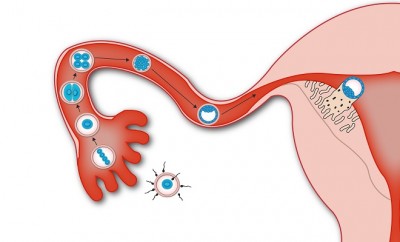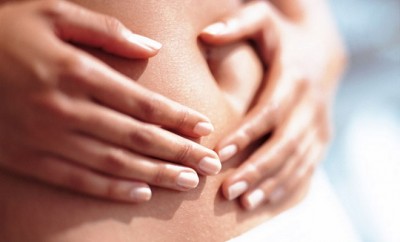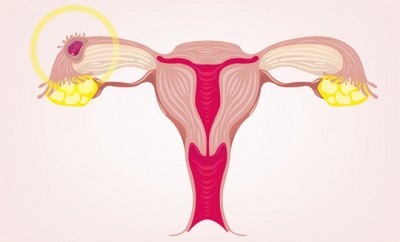Implantation Pain: The Philosophy Behind It
Implantation pain is one of the first signs of pregnancy experienced by around 15-30 percent of all expectant women. It can be caused by ovarian cysts, expanding ligaments and hormonal changes. Implantation pain is very mild and can be distinguished from menstruation aches with the help of additional symptoms, such as tenderness in breasts, fatigue, heaviness in the stomach and bleeding.
What Are the Causes of Implantation Pain?
The genesis of implantation pain can be traced back to the ovulation process. During ovulation, a woman releases a mature egg from her ovaries. It is then fertilized by a sperm and starts to travel to the endometrial lining of the uterus. This lining is very rich in nutrients since it is supplied with sufficient blood from the blood vessels, which form a huge network around it. Implantation cramping takes place when a newly formed fetus (called a zygote) gets attached to this lining. Due to this activity, an expectant woman may experience painful sensations often accompanied by shedding of blood (through the vagina).
Other Triggers of Pain in the Uterus That Can Easily Be Mistaken for Implantation Cramping:
- Ovarian Cysts
Uterine cramps may also occur due to formation of tiny fluid-like sacs known as ovarian cysts during ovulation. These normally fade away once the egg is released. In such a case, bleeding and pain in the abdomen are usually experienced. The only difference between pain due to ovarian cysts and implantation cramps is the intensity of the blood flow and the severity of cramps.
- Expanding Ligaments
Another cause of pain is the growth of the round ligaments of the uterus. They gradually expand to accommodate the newly-formed and quickly-developing fetus. Such pain could also be felt due to a miscarriage. However, in this case the pain is intense and the bleeding is heavy.
- Hormonal Changes
Expectant women can also experience implantation cramping due to hormonal changes. Some common hormones that are released during early stages of pregnancy include estrogen, human chorionic gonadotropin and progesterone. When each of these three is produced in high levels one may experience the mild abdominal pain and cramps.
What Is the Difference Between Implantation Pain and Menstrual Pain?
One way to distinguish menstrual cramping from implantation pain is to check the dates. In most women implantation cramping occurs around 7 days before the missed period. Yet another difference between the pain due to implantation and menstrual cramps is scanty bloody discharge. It looks like spotting and can last for as many as two days or as few as five minutes.
It is also possible to tell if your cramps are due to a forming pregnancy by checking the color of the blood. Menstrual blood is bright red. It is quite different from implantation blood which is either pinkish or brown. This is due to the fact that implantation bleeding leads to excretion of blood which is not fresh unlike menstruation – hence the difference in color exists.
How Implantation Pain Feels Like
During the egg-embedment process a very mild pain is usually felt. Moreover, it is often accompanied by a bit of tightness around your lower stomach. Sometimes this pain is extremely mild and you might not even discharge any blood. This perhaps explains why there are many women who actually don’t feel the impact of implantation cramping. If you’re experiencing pain in your shoulders, tiredness, weakness, dizziness, pelvic pain, clots in the implant blood or extremely heavy bleeding then you’re advised to seek instant medical help as this could be due to ectopic pregnancy or even more serious medical concerns.
When Is It Right to Contact an Expert?
While painful feelings during implantation are normal, anytime you’re concerned you should arrange to visit a medic. However, if the pain is tolerable you may want to wait at least three to four days to see if it fades away. The following symptoms are out of the norm. If you feel something like this, you should contact your health care expert immediately. Note them:
- abnormally intense bleeding;
- pinkish or grayish tissues in your discharge;
- bleeding more than 4 days;
- tenderness in the lower belly;
- unbearable pain that lasts more than 24 hours;
- excruciating pain on one or both sides of your lower abdomen;
- severe implantation cramps;
- heavy bleeding and strong cramps with lightheadedness.
If you’re experiencing pain due to implantation, try drinking at least 8 glasses of water per day. Even if you’re not a fitness enthusiast, it’s high time to get up on your feet and to take a brisk walk. You can also try exercising your abdominal muscles through kegel exercises and pelvic tilts.
If things are not getting any better, try taking a warm bath. You can as well try an electric heating pad. Only be careful not to apply too much heat (or pressure) on the painful region. A gentle massage could also help reduce the unpleasant symptoms.
You’re as well encouraged to increase your fiber intake to avoid constipation. If you think constipation is the cause of your abdominal pains, try changing your diet. You’ll want to use conventional medicine if things get out of hand. In the same vein, you’re advised to avoid starving as this could make otherwise mild pain severe.
Your lifestyle habits could also contribute to worsening the pain. For this reason, you’re advised to avoid stress. Consider changing your work schedule, get some rest, talk to a close friend (preferably a mature woman), and try meditation or yoga. In a nutshell, take care of yourself to avoid instances where pain (which should otherwise be mild) becomes unbearable or risky. It’s also not advisable to engage in sex until this pain (and bleeding) subsides.
To sum up, implantation cramping and abdominal discomfort should not be taken lightly. In fact, any vaginal cramping which occurs in the middle of the normal menstrual cycle should be discussed with a medical expert, as there could be quite a couple of reasons for the same symptom. If your pregnancy is confirmed, it becomes even more crucial to talk to a doctor, for both you and your unborn child’s well-being.
Recommended reading:
Implantation Cramping – Causes, Symptoms and Treatment
Can You Feel Implantation? A Guide To Implantation Bleeding
Signs of Implantation Bleeding – Implantation Bleeding and Symptoms
Discover the Most Common Implantation Symptoms
Signs Of Successful Implantation: Why It Is Important To Stay Optimistic














